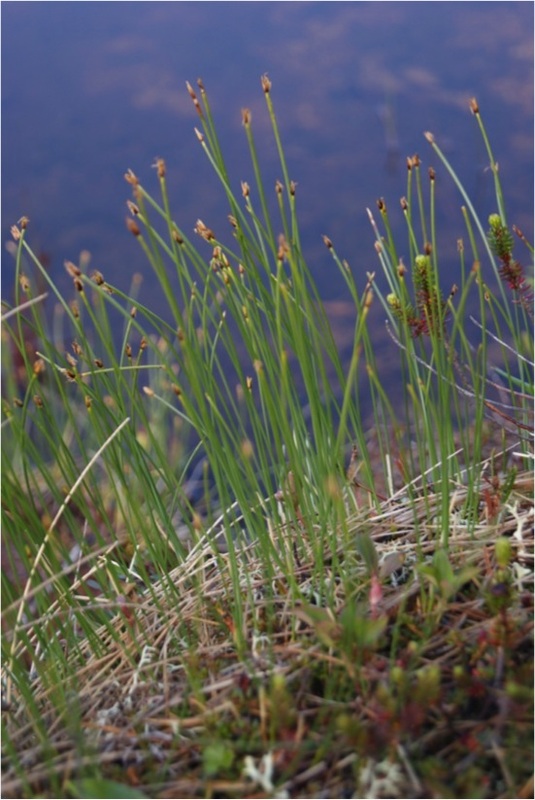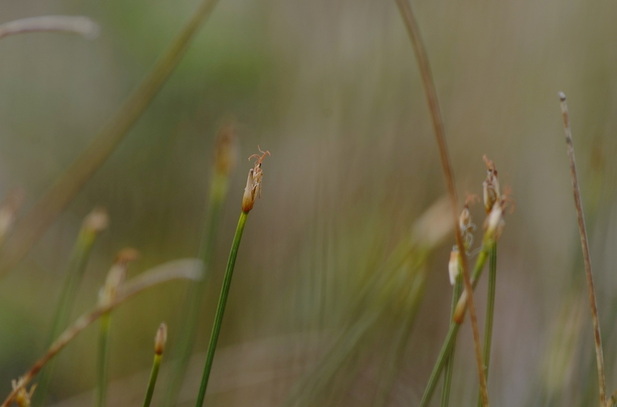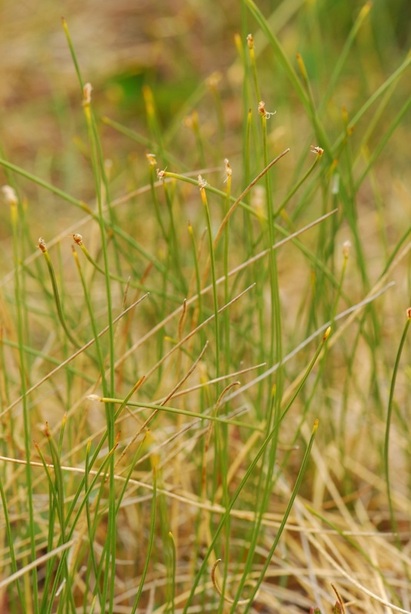Tufted clubrush • Trichophorum cespitosum, Scirpus cespitosus
|
Photos by Natalie Graham (top left), Andrew Trant (bottom left), and Kelly Fretwell (right).
|
Identification
Tufted clubrush is a perennial sedge (despite its name) that grows in dense tufts, commonly forming tussocks. Its slender stems are smooth, tapered, circular in cross-section, and reach 10-40 cm tall. It has reduced, scale-like leaves at the stem base, and a single 5 mm long sheathing stem leaf just up from the base. Its terminal inflorescence is a brown spike composed of 2-4 flowers. The lowest bract of the spike has an elongated midvein that forms a blunt awn the length of the spike. It bears 2-3 egg-shaped seeds: click here for more detailed information on these seeds.
Habitat & Range
Tufted clubrush grows in bogs, fens, and wet meadows; along gravelly and peaty shorelines; and in wet tundra. It is common throughout BC from low to alpine elevations, and is found throughout much of North America.
Similar Species
Low clubrush (Isolepis cernua) is a similar annual sedge found mostly in southwest BC and southward. White beak-rush (Rhyncospora alba) can also appear similar to tufted clubrush when neither plant is in flower.
iNaturalist
https://www.inaturalist.org/taxa/204169-Trichophorum-cespitosum
Tufted clubrush is a perennial sedge (despite its name) that grows in dense tufts, commonly forming tussocks. Its slender stems are smooth, tapered, circular in cross-section, and reach 10-40 cm tall. It has reduced, scale-like leaves at the stem base, and a single 5 mm long sheathing stem leaf just up from the base. Its terminal inflorescence is a brown spike composed of 2-4 flowers. The lowest bract of the spike has an elongated midvein that forms a blunt awn the length of the spike. It bears 2-3 egg-shaped seeds: click here for more detailed information on these seeds.
Habitat & Range
Tufted clubrush grows in bogs, fens, and wet meadows; along gravelly and peaty shorelines; and in wet tundra. It is common throughout BC from low to alpine elevations, and is found throughout much of North America.
Similar Species
Low clubrush (Isolepis cernua) is a similar annual sedge found mostly in southwest BC and southward. White beak-rush (Rhyncospora alba) can also appear similar to tufted clubrush when neither plant is in flower.
iNaturalist
https://www.inaturalist.org/taxa/204169-Trichophorum-cespitosum
References
Pojar, J. and MacKinnon, A. (1994). Plants of Coastal British Columbia. Vancouver, BC: Lone Pine Publishing. P. 406.
Trichophorum cespitosum (L.) Hartm. In Klinkenberg, Brian. (Ed.). E-Flora BC: Electronic Atlas of the Plants of British Columbia. Lab for Advanced Spatial Analysis, Department of Geography, University of British Columbia, Vancouver. Accessed 07/08/2014.
Authors and editors of page
Kelly Fretwell and Brian Starzomski (2014).
Pojar, J. and MacKinnon, A. (1994). Plants of Coastal British Columbia. Vancouver, BC: Lone Pine Publishing. P. 406.
Trichophorum cespitosum (L.) Hartm. In Klinkenberg, Brian. (Ed.). E-Flora BC: Electronic Atlas of the Plants of British Columbia. Lab for Advanced Spatial Analysis, Department of Geography, University of British Columbia, Vancouver. Accessed 07/08/2014.
Authors and editors of page
Kelly Fretwell and Brian Starzomski (2014).







